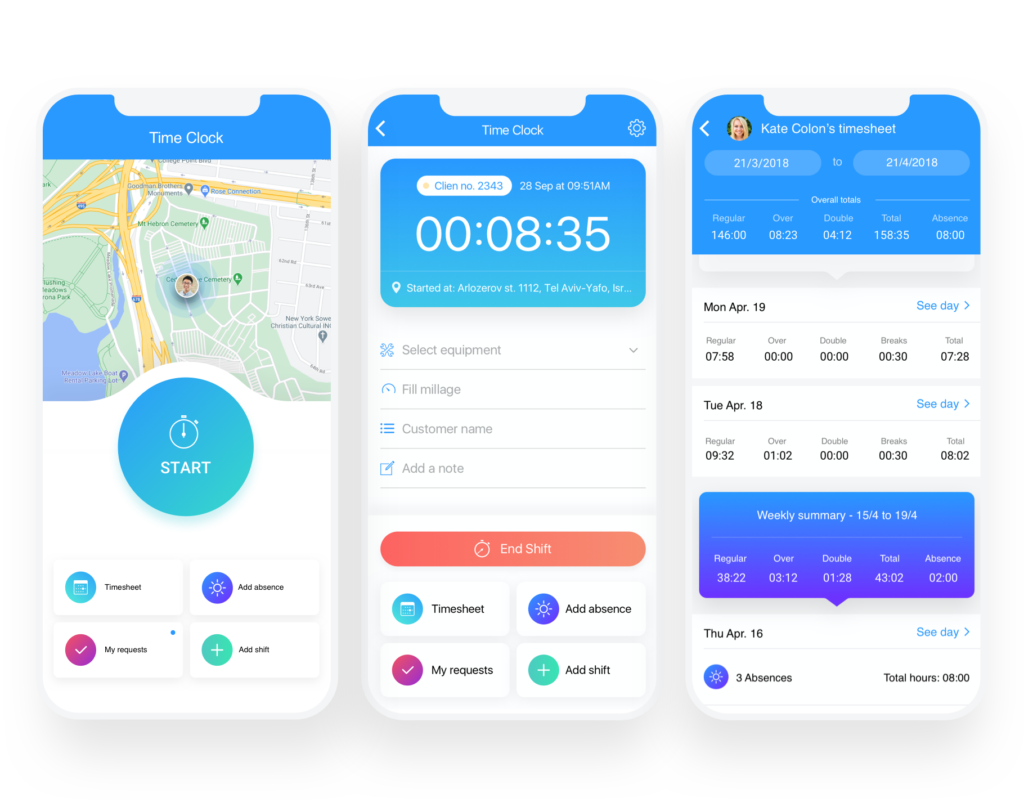Without the proper practices and tools, employee timekeeping is an absolute, time-consuming struggle with plenty of room for costly mistakes. We’ve listed some employee timekeeping best practices to help you transform your employee timekeeping process into a more efficient, organized, and accurate one.
Sure, you trust your employees.
But when you don’t have a solid employee timekeeping strategy in place, even the best of your employees may sneak in a few minutes here and there. Seems harmless, right? Now multiply those few minutes by your entire workforce and the number of shifts they work and you’re looking at a big chunk of money.
Especially tracking work hours with pen and paper or other outdated tools leaves room for time theft and buddy punching and is prone to costly mistakes.
Luckily, we’ve got you covered with these employee timekeeping best practices to ensure that your time tracking is as accurate and efficient as possible.
Track Your Employees Work Hours With Complete Ease & Accuracy
Allow employees to clock in & out straight from their mobile phones, track their work hours & location in real-time, record hours directly onto timesheets, and process for payroll – all with the click of a button.
Employee Timekeeping Do’s
Use an efficient employee timekeeping system
The Fair Labor Standards Act (FLSA) in the US and the European Working Time Directive (EWTD) in the European Union allows employers to choose their time tracking tools and expect all records to be accurate and up to date. If you’re still working with pen and paper or have your employees punch their hours on a punch clock, our first and most important tip is to automate employee timekeeping by switching to a digital time and attendance system. This allows you to easily track your employees’ work hours with more efficiency and accuracy and minimizes room for human error. It also gives you a clear overview of the amount of hours worked or spent on a particular project, allows your staff to review and approve their timesheets, and simplifies your entire payroll process.
With a record 43% of employees admitting to not giving the correct amount of hours per shift, digitizing employee timekeeping is the way forward. Some employee timekeeping software solutions, such as Connecteam, also allow you to set up geofences around work areas to ensure that your workers are precisely where they need to be when they clock in and out.

Keep precise records of time worked
Accurate data on time and attendance is the backbone of any employee timekeeping initiative. To get this right, record work hours down to the minute instead of making estimates and record time as it is worked – rather than relying on your or your employees’ memory.
Time and attendance software easily lets you and your team record accurate work hours in real-time, which you can then easily manage and review.
Unleash the Full Potential of Your Business with Connecteam’s All-in-One Management Software –
Show workers the benefits of employee timekeeping
Show your employees the benefits of time tracking and create a company culture in which timekeeping is valued. Employees have a lot to gain from automating time tracking, especially since they no longer need to do it manually and can be confident that they get paid for their exact work hours. Apps such as Connecteam count up all the hours, so employees can also view how many hours they have accumulated.
Employees will be content and glad to adopt the new tool. Once employees understand that there are fewer errors, they will be happy to adopt the new tool and sign in and out.
Allow employees to have sufficient break times
Employees require suitable breaks during their workday and should definetly not be penalized for taking a lunch break. That said, not providing sufficient breaks could lead to time theft.
By allocating time for breaks, you give your employees the opportunity to recharge, enabling them to “get back at it” and perform at their best. Breaks are also a great way to show your team that you value them and encourage employee engagement as workers take this opportunity to talk to one another.
You should check with state labor laws to ensure you are providing the right amount of time for breaks.
Compensate training & travel time
For employee timekeeping to be just and in compliance with the fair labor standards act (FLSA) and many state laws, you are required to pay your employees for certain nonproductive time in addition to the time they actually spend working. This includes for time spent in training or traveling. Another employee timekeeping best practice is therefore to instruct your employees to record their time for such instances and make sure that they have the right tools to do this as they might be outside their regular work environment during these periods.
Have employees verify their work hours
Require your staff to review their time records at the end of each pay period and confirm that these are correct. This allows you to make corrections before processing payroll and prove that your employee has confirmed their time records’ accuracy. Note that making changes to an employee’s time records without their approval is risky business and has led to numerous lawsuits.
Employee Timekeeping Don’ts
Make it a hassle
Your employees should be able to record their work hours easily and in not more than a minute each day. If this isn’t the case, they’ll be more likely to be reluctant to doing it properly. Choose a employee timekeeping method that is fast and intuitive.
Miss payment deadlines or withold pay
By law, you are required to pay your employees for all of their work hours on the next regularly scheduled payday, whether or not they followed your company’s timekeeping policies. This means that even if there are discrepancies over the salary, the employee must still receive full payment.
If the employee fails to hand in or sign their timesheet, promptly request the employee and their direct manager to submit and confirm the work hours and pay the employee accordingly.
Have unfair payment
Employees should understand how to keep track of their hours. The process shouldn’t be complicated for employees to fill out. Depending on the state will determine how many breaks they have by state law. This could mean that they only clock in the morning and clock out in the evening. Others may ask them to clock in and out at break times as well.
Ensure that overtime is paid and that you allocated that amount of overtime. Paying too much overtime can eat into your profits. You can make your employee’s hours more specific by requesting the project or target they were working on. Apps such as Connecteam allow you to set up geofencing on the clocking in so that employees can only clock in from the exact location.
To effectively track employee hours and ensure compliance with labor regulations, it’s essential to use reliable time-tracking tools. These tools not only monitor work hours but also help in managing overtime and ensuring adherence to labor laws. For a comprehensive list of top employee tracking apps, including those that offer location-based clock-ins, you can refer to our curated selection of the best apps to track employees.
Lose employees’ timesheets
Make sure you have saved a copy of your timesheets because you wouldn’t want to lose those files. You need to ensure that where you saved the files is safe and that they are not deletable in a click.
The FLSA requests that employers keep the salary sheets, keep time cards, and other payroll records on which salary calculations are based for at least two years. You must also keep records required for federal tax purposes for at least four years. As it varies which information should be kept for state, check with your local government for any additional recordkeeping rules.
Allow employees to work “off-the-clock”
In order to determine the amount your staff should receive under the FLSA, it is necessary to know how many hours they worked. Therefore, as an employer, you cannot request or permit your non-exempt staff to work off-the-clock – even if they may want or request to do this out of goodwill. To avoid any pitfalls, be sure to include a policy that clearly states that working off-the-clock is not allowed and set up controls to prevent it from happening.
How Connecteam Can Help With Employee Timekeeping
Connecteam is an all-in-one employee timekeeping software solution that helps you to record, track, review, and manage your employee work hours with complete ease and accuracy, straight from your mobile device or desktop.
With the fully automated Time Clock you will enable your employees to clock in and out and automatically record their work hours with just a click – whether they are working behind their computer or on a remote project using the mobile app. You have a clear and complete real-time overview of who has clocked in, when, and from where.
You can set up a digital geofence around your workplaces to restrict from which area your employees can clock in and out, and even track your remote-working employees’ real-time location while on the job. So wave goodbye to buddy punching and time theft.
All tracked hours are automatically organized and ready for review on a digital Timesheet – so no collecting paper timesheet or estimating hours – leaving you with 100% acurracy and transparency. Here you can easily see all recorded time, such as total daily work hours, the number of hours worked during a payroll period, overtime, breaks, time off, and any irregularities.
When ready, you can export the timesheets directly to your Payroll software or use one of Connecteam’s payroll integrations. This allows you to skip the entire manual process and save valuable time and effort.
📚 You May Be Interested In:
Boost productivity and simplify time tracking for your remote team! Check out our guide to the best remote employee time tracking apps to manage work hours, improve accuracy, and enhance operational efficiency. Discover the perfect app for your team today!
Ditch Pen & Paper and Move to the Future of Employee Timekeeping!
Manage your entire timekeeping process from beginning to end with complete ease with the #1 timekeeping software – Connecteam.




